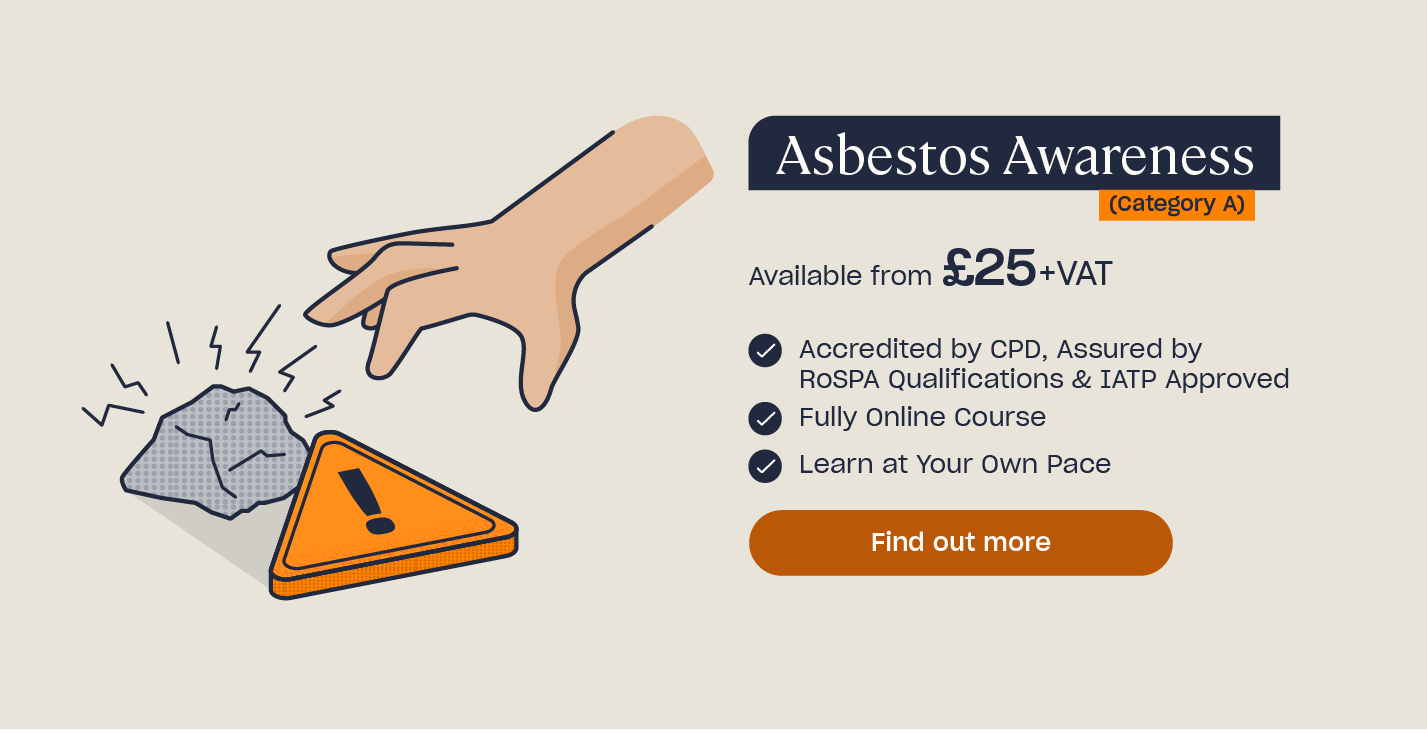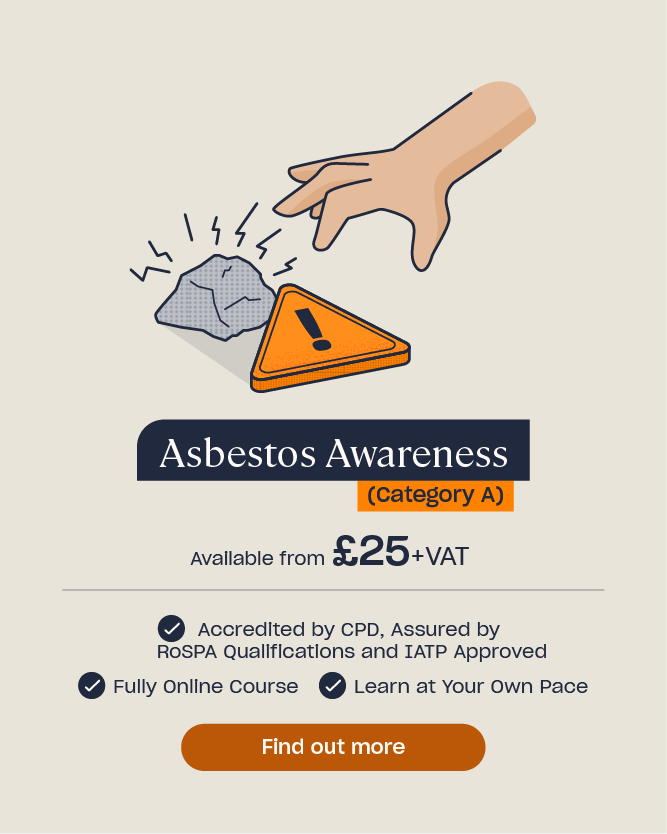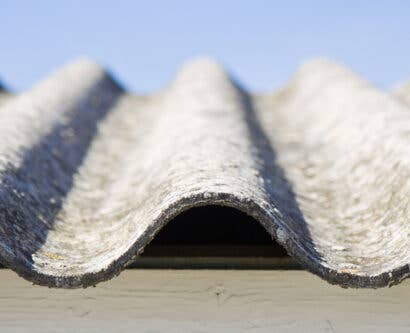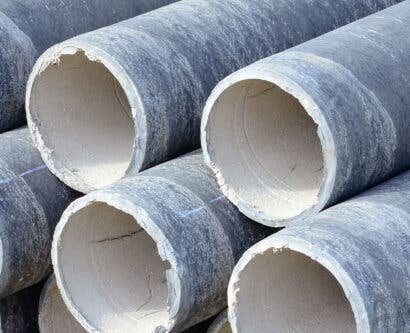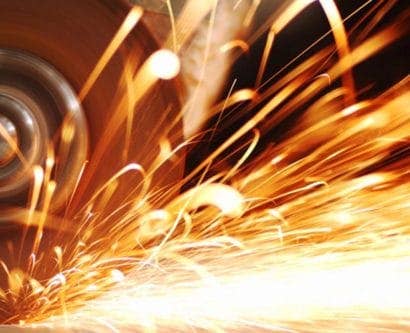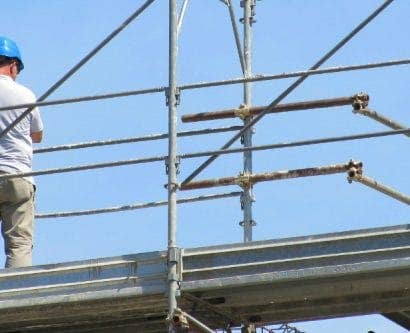What is Gypsum in Construction?
Gypsum is an important natural mineral used in materials and products for many different industries – particularly in construction. You may not have heard of gypsum before, but you will certainly have come across some of the things it’s used in – in fact, gypsum is all around us. In recent years there have been some misconceptions about the risks associated with using gypsum for construction, particularly whether or not gypsum contains asbestos.
In this article we’ll outline what gypsum is and the important role it plays in the construction industry. We’ll also explain the risks associated with gypsum powder and the relationship between gypsum and asbestos in construction.

What is Gypsum?
Gypsum is a soft sulphate mineral with a white or grey colour, known scientifically as calcium sulphate dihydrate. It has the chemical formula CaSO4 2H2O, meaning it’s made up of calcium, sulphur, oxygen and water.
It is a naturally occurring mineral found in sedimentary rock layers and forms when water evaporates in mineral-rich marine soil environments. As time passes, more water evaporates, more minerals are brought to the surface and a solid deposit forms – this is gypsum.
Gypsum deposits are found and mined worldwide, from the US and Brazil to Russia and Thailand. It is most commonly extracted using surface mining, then crushed using industrial machines and screened to sort it into different-sized pieces with different commercial uses.
The mineral has been used in society for thousands of years. For example, alabaster – a solid form of gypsum – was used by ancient civilizations to create sculptures, while gypsum powder was used as a building material for the Egyptian pyramids.
Today, gypsum can be found in the walls, floors and ceilings of many buildings, in fertilisers, as a food additive, in toothpaste, in medicine for creating casts and in many other places. Gypsum is hugely beneficial in our modern society, but it has its most significant uses in construction, where its properties, such as sound insulation and fire resistance, have improved the safety and efficiency of construction projects.

Types of Gypsum in Construction
If you haven’t heard of gypsum before, you may be surprised at the number of building materials made from, or containing, gypsum. When added to building materials, gypsum improves that material’s functional and structural properties, meaning gypsum-based materials are used widely and frequently in construction.
When used in building materials for construction, some of the properties gypsum transfers to that material include:
- Heat resistance.
- Moisture resistance.
- Sound absorbency.
- Fire resistance.
- Strength and durability – including crack resistance.
- Fast setting and hardening.
What is Gypsum Powder?
In construction, gypsum is most often used in powder form. When solid, natural gypsum is heated up, it loses some or all of its water molecules, turning it into a powder. In the construction industry, this is known as plaster. Depending on how much heat is applied to the gypsum, you can create different types of gypsum plaster with varying construction uses.
When water is added to the plaster, it sets and becomes solid gypsum again. This allows the gypsum to be moulded into almost any shape or smoothed flat for surfaces, providing many uses for construction.

How is Gypsum Used in Construction?
Some of the main uses of gypsum in construction today include, but are not limited to:
- Plasterboard: Also known as drywall or gypsum board, plasterboard is made from a gypsum core, which sometimes contains additives to improve its structural qualities. The core is sandwiched between thick paper called a backer and facer. Plasterboard has fire resistant and sound proofing properties, is light, quick to install and cheap. This makes it a popular choice of material for building interior walls, including partition walls and ceilings, meaning most modern residential, industrial and commercial buildings will contain gypsum.
- Decorative plaster: When gypsum is heated to make plaster, this is known as plaster of Paris. Plaster of Paris is useful for creating moulds, models and casts in construction and decorating. It is also quick drying and usually shrink and crack resistant once dry.
- Concrete: Gypsum is added to cement to increase the time taken for the cement to dry and harden, this improves the stability of the resulting concrete.
- Gypsum fibreboard: Similar to plasterboard, gypsum fibreboard is used to line walls, ceilings, roofs and floors. It has soundproofing qualities as well as being shock and humidity resistant.
- Building plaster: Gypsum plaster is used in walls and ceilings. It is easy to apply and sets quickly making it a popular choice of building material.
- Plaster block: This comes in the form of gypsum tiles which are used in ceilings and gypsum blocks which are used for partitions in buildings. Their fire resistance makes them useful for projects like public buildings or buildings with a high fire risk.
- Gypsum-based self-levelling screed: Used for ground levelling in buildings, this is a self-levelling mortar that can also be used as a base for ground decorative materials. It is stronger, more thermally stable and less prone to cracks than cement mortar.
It’s clear that building materials containing gypsum are used at some point during the construction of most buildings, showing just how useful and effective it is for the industry. However, because gypsum has been used in construction for so long, there’s a risk that some of these gypsum-based materials could also be contaminated with asbestos.

Does Gypsum Contain Asbestos?
The simple answer to this question is no, in its natural form gypsum does not contain asbestos. However, according to the Health and Safety Executive, there is a risk to health when working with gypsum-based plasterboard, if gypsum dust becomes airborne, as the dust may contain asbestos fibres. With this warning in mind, it’s unsurprising that people may believe gypsum contains asbestos.
Although this is not the case, there is a link between gypsum and asbestos in the construction industry which means that asbestos control measures must be taken in some scenarios when working with gypsum-based building materials.
Does Plasterboard Contain Asbestos?
In the 1930s, gypsum plasterboard became a popular building material in the construction industry. At the same time, another mineral was becoming a popular addition to construction building materials – asbestos. Construction workers, and the wider population were unaware of the serious health risks we know about today, that come from inhaling and ingesting asbestos fibres.
Asbestos was viewed in the same light as gypsum – as a useful substance which could improve the properties of building materials and the efficiency of construction projects. Like gypsum, asbestos was an effective insulator and strengthener, had fire resistant and sound proofing properties and could protect against corrosion. For these reasons, asbestos was used as an additive in various building materials – including in plasterboard. This means that in buildings constructed between the 1930s, when using plasterboard became popular, and the 1990s, when the use of asbestos was prohibited, there’s a chance that the plasterboard in the walls and ceiling will contain asbestos.

When plasterboard is painted, the asbestos becomes sealed inside and the risk of harm is greatly reduced as asbestos fibres need to be airborne to reach the lungs. However, if that plasterboard were to be disturbed or damaged, then the asbestos fibres could be released and become dangerous. This means that if you are looking to do construction on a building which was built during this time period, it’s extremely important that the area is tested for asbestos and a risk assessment is carried out first. If you’d like more information on how to carry out an asbestos risk assessment, check out our article, here.
It has become common environmental practice in the construction industry to recycle old gypsum plasterboard into new plasterboard. To do this, the boards are broken down to a powder, at which point the powder is tested for asbestos. As it has been illegal since 1999 to use asbestos, if the tests identify asbestos in plaster then it cannot be reused.
It isn’t just plasterboard produced during this time that poses an asbestos risk – in fact, one of the most common materials asbestos was used in during this time was joint compound which supports plasterboard. Joint compound is made primarily from gypsum powder but when using asbestos was still legal, asbestos was often also included in the mix. Again, in its solid form it isn’t necessarily dangerous to you, but as soon as dust or powder is produced, allowing asbestos fibres into the air, there becomes a serious risk of long-term harm.
As well as the risk of gypsum-based building materials containing asbestos as an additive, asbestos-free building materials can also become contaminated if installed in a building with materials containing asbestos. So, even if a gypsum-based material didn’t contain asbestos when it was made, it can still become contaminated after being installed.
Want to Learn More?
Our Asbestos Awareness course teaches you about what asbestos is and where you might encounter it, as well as the dangers of working with asbestos and what to do if you discover it, helping you to keep yourself and others safe from harm.
Can Gypsum Cause Harm?
Although natural gypsum doesn’t contain asbestos, there is a risk that gypsum-based building materials will be contaminated with asbestos if made before asbestos was banned in 1999. However, it is the asbestos fibres and not the gypsum itself that poses the most severe risk to your health.
According to the Health and Safety Executive, asbestos is the biggest occupational disease risk to construction workers.
Despite gypsum being nontoxic, if ingested or inhaled regularly, any construction dust can cause serious harm to health, including gypsum dust. There should be control measures in place to protect workers in the construction industry from construction dust and the Control of Substances Hazardous to Health (COSHH) Regulations sets strict legal limits on the amount of construction dust someone can be exposed to.

In this article, you’ve learnt what gypsum is and how important it is for the construction industry, as well as the risks associated with gypsum powder and its relationship to asbestos. We hope you’ve found this article helpful and informative, whether you work in the construction industry or just want to learn more about a substance around us.
Further Resources:
- What is Asbestos Awareness Training & Who Needs it?
- What is Asbestos?
- How to Conduct an Asbestos Risk Assessment
- Asbestos Quiz
- Can You Remove Asbestos Yourself?
- What are the Differences between Friable and Non-Friable Asbestos?
